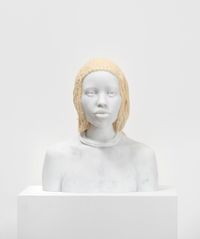

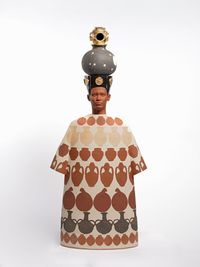
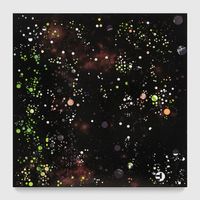
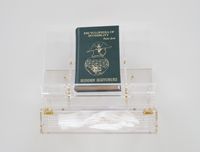
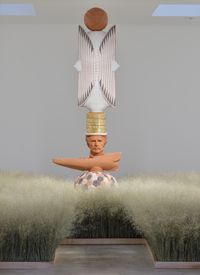
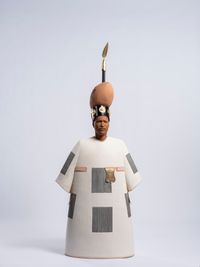
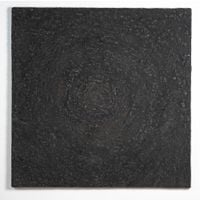
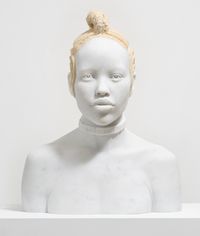
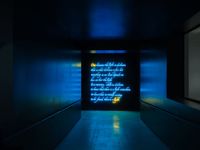
Marian Goodman Gallery Los Angeles is pleased to announce a solo exhibition of Tavares Strachan. Titled Magnifcent Darkness, this immersive exhibition will feature several new bodies of work across six diverse and site-specifc environments. Through an interconnected array of works comprising ceramic, bronze, marble, hair, neon, sound, and painting, this exhibition collectively professes a visual allegory toward the overarching exploration of light and darkness.
Strachan's work summons historical and cultural references, creating essential contextual collisions and connections to his celebrated, ongoing research project, The Encyclopedia of Invisibility. For this exhibition, a central installation from the Encyclopedia forefronts the surrounding gallery spaces, bringing light to a number of 'invisible histories' that have largely fallen by the historical wayside. A special, smaller format of the Encyclopedia in book form will also be on view. Nearby, a new work in neon, There is a Light in Darkness, draws on the words of James Baldwin and serves as the source for the audio work that can be heard throughout the exhibition space.
In the Seward Gallery, a vast and transportive earthen floor grounds two near-life-sized ceramic sculptures, Matthew Henson (Hunter's Shirt Stacked with Football and Spear) and Andrea Crabtree (Potter's Shirt Stacked with Diver's Helmet), representing the figures of Matthew Henson, the African American explorer who discovered the North Pole, and Andrea Motley Crabtree, the first African American female diver for the U.S. Navy. Themes intrinsic to Strachan's practice—ranging from human aspiration to the chronicle of elided histories—are evoked here through depictions of Arctic exploration and deep-sea discovery. Clay, as integral to human evolution and the creation story, is found repeatedly throughout the exhibition, from the Seward Gallery floor to the numerous ceramic sculptures on view.
In an intimate space of the main lobby sits Amina (A Map of the Crown), a bronze bust sculpture adorned with a traditional West African hairstyle. The closeness of these materials ofers an insightful reconciliation of the distance between the deeply personal, political, and present nature of hair and the venerable qualities bestowed upon bronze sculpture—some of the earliest and most accomplished bronze works date to Africa in the 10th century. A new series of paintings also debuts here. Mind Field No. 1 sits in dialogue with Amina, together begetting references ranging from the history of the monochrome to metaphorical notions of hair as a protective layer, symbol of knowledge, and means for communication and transport.
In the adjacent Hudson gallery, a 'meadow' of dried rice grass transforms the space into a landscape, referencing rice as a staple of the Afro-Caribbean diet. Viewed from above, the terrain is shaped in the form of the Ghanaian Adinkra symbol for Nsaa, which symbolizes quality and durability, and metaphysically denotes excellence and authenticity. The dramatic foorscape fnds its focal point in Jah Rastafari (Stacked with Pineapple, Shield and Football), 2023, a multifaceted ceramic sculpture illustrating a bricolage of spiritual and cultural forms from disparate centuries.
The Main Gallery continues the dialogue of the interrelation of light and darkness opening with the related words of Baldwin. Split in two, the divided spaces become each other's complements. In the darkness of one half, new Galaxy paintings, depicting distant constellations and galaxies as symbols of the invisible systems that structure our world, are placed in relation to three ceramic sculptures: Inner Elder (Mary Seacole); Inner Elder (Biko as Septimius Severus); and Inner Elder (Nina Simone as Queen of Sheba), historical fgures who carry their own symbolic cosmology and are symbols of a lost language. These works explore the traditions of storytelling in West African and Afro-Caribbean cultures, serving the dual purpose of vessels made of earth that host the daily materials of rice and water, and canvases to document stories through symbols and patterns. The contrasting, light-flled gallery presents a white painting of hair, Mind Field No. 8, alongside three white marble sculptures, Makeda (A Map of the Crown), Moremi (A Map of the Crown), and Amanirenas (A Map of the Crown), collectively drawing questions around whiteness and related visual discourses of ancient sculpture.
Press release courtesy Marian Goodman Gallery
1120 Seward Street
Los Angeles, CA 90038
United States
Tuesday – Saturday, 10 am – 6 pm